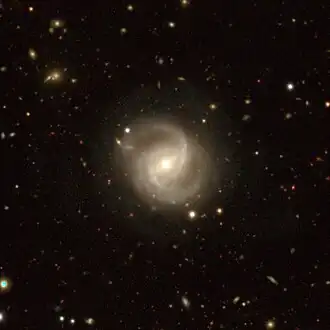NGC 438
| NGC 438 | |
|---|---|
 NGC 438 imaged by legacy surveys | |
| Observation data (J2000 epoch) | |
| Constellation | Sculptor |
| Right ascension | 01h 13m 34.1s[1] |
| Declination | −37° 54′ 06″[1] |
| Redshift | 0.011641[1] |
| Heliocentric radial velocity | 3,490 km/s[1] |
| Distance | 157.1 ± 11.1 Mly (48.18 ± 3.39 Mpc)[1] |
| Apparent magnitude (V) | 13.42[1] |
| Absolute magnitude (V) | -20.86[1] |
| Characteristics | |
| Type | (R')SAB(s)b:[1] |
| Size | ~104,300 ly (31.98 kpc) (estimated)[1] |
| Apparent size (V) | 1.4' × 1.1'[1] |
| Other designations | |
| ESO-LV 2960070, ESO 296- G 007, IRAS 01112-3810, 2MASX J01133415-3754057, MCG -06-03-029, PGC 4406[1] | |
NGC 438 is an intermediate spiral galaxy of type (R')SAB(s)b: located in the constellation Sculptor. It was discovered on September 1, 1834, by John Herschel. It was described by Dreyer as "pretty faint, small, round, gradually a little brighter middle."[2]
One supernova has been observed in NGC 438: SN 2024vjc (type Ib, mag. 18.97).[3]
See also
References
External links
 Media related to NGC 438 at Wikimedia Commons
Media related to NGC 438 at Wikimedia Commons